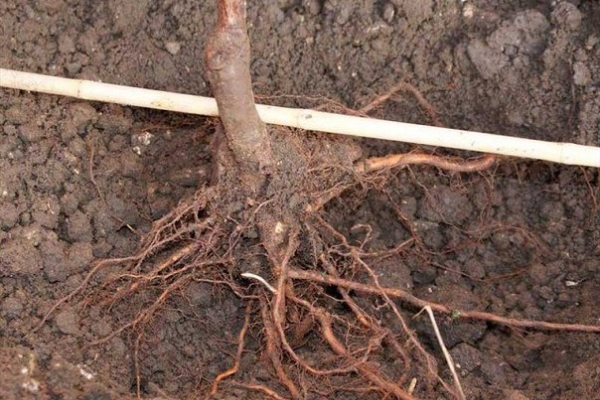For a long time, the pear was cultivated only in the southern regions, where this process has an industrial scale. It is isolated by the high demands of the tree for growing conditions. But, specially developed agrotechnology and the appearance of zoned varieties, significantly expanded these boundaries. Of particular importance in the development of the fruit tree is the correctness and timeliness of planting.
In this article we will learn when it is better to plant a pear, how to plant a pear in the fall, how to transplant a pear to another place, and also give the most detailed instructions for this.
Table of contents
- Benefits of Autumn Pear Planting
- Landing time
- Requirements for the landing site
- Preparation of the landing pit
- Selection of seedlings and preparation for planting in September
- How can you plant a seedling in open ground: a step by step guide
- Proper preparation of young pears for the winter
- How to transplant an adult pear to a new place?
Benefits of Autumn Pear Planting
The autumn season is characterized by the ability to choose high-quality planting material. Most nurseries digging seedlings carried out in the fall, so the roots of the tree are preserved in the most natural form. In addition, seedlings in the fall are much cheaper.
During the autumn planting young sapling has time to develop the root system. In the spring of these trees, the main forces go to the growth of the vegetative mass. Therefore, the saplings planted in the fall, are ahead in the development of spring planting trees for 20 days. This is an important factor for the overall formation of the pear.
Autumn planting is relatively simple.During this period, the main thing is to plant the pear correctly and take care of the winter shelter of the seedling. All other actions will make nature. Autumn rains will provide the root lump with the necessary moisture, and it will develop until the ground cools to + 4 ° C.
Planting pears in the fall has its drawbacks. These are rodents who, with the onset of cold weather, love to eat young seedlings. Sudden cold can ruin an immature tree. Therefore, in the northern regions of the pear plant only in the spring. If you listen to the recommendations of experienced gardeners, the risks of these negative moments can be minimized.
Landing time
Autumn planting pears produced in the rest period of the seedling. At this time, all biochemical processes in the tree are aimed at adapting the root system to the harsh climatic conditions. Outwardly, this manifests itself in massive leaf fall.
Determining the timing of planting, it is necessary to focus on the regional climate. For the middle band this is the third decade of September and until mid-October. In the southern regions are planted from October to mid-November. When deciding to plant a pear sapling, it is necessary to monitor the weather forecast and be guided by the average temperature optimum.
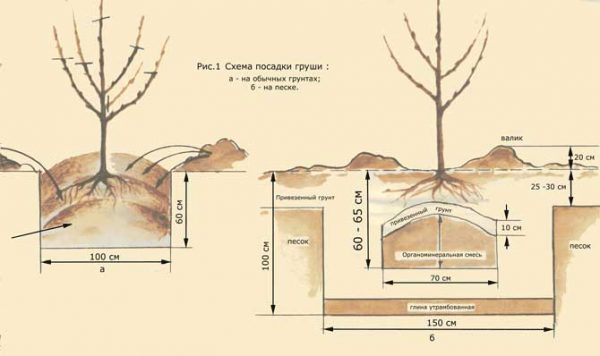
It is very important to plant a sapling 2 to 3 weeks before the onset of stable frosts. Otherwise, constant temperature drops will cause periodic freezing and thawing of the soil. Pear roots will be pushed out of the soil, freeze and dry. All this leads to the inevitable destruction of the tree.
Requirements for the landing site
When choosing a place for a pear, you need to take into account its genetic features - its thermophilicity. Therefore, the area for the tree should be protected from the effects of cold northern winds and drafts. Also, the place should be as lit as possible, this increases the level of photosynthesis, respectively, the quality and quantity of the crop. WITHThe best option for a pear is the elevated south or southeast side of the plot.
In the heavy and poor soil, the pear will develop well only in the first years, until its roots grow into the substrate introduced into the planting hole.For the fruit tree, moisture-absorbing, cultivated loamy and sandy soils, the humus horizon of which is not less than 20 cm, are preferred. Acidity is from 5.0 to 6.5.

Preparation of the landing pit
For autumn planting, the selected site must be prepared in late spring or early summer. So the necessary elements brought into the soil will mix naturally, and a favorable microbiological environment will arise for the roots of the seedling. During digging for every 1m2 add:
- compost 6 kg,
- superphosphate 60 g;
- potassium salt 30 g
The quality of planting pits depends on the development of seedlingswhich will receive food from the substrate contained in it in the first years after planting. The depth of the pit should be 60 cm; pear core roots grow to such a size in the first 2 years. The diameter of the pit on average 80-100 cm
The walls of the pit should be steep - this ensures proper soil shrinkage. When digging a hole, it is necessary to divide the excavated soil into two parts.Surface soil will be used in the process of planting, the lower part is not useful. After that, stepping back 30 cm from the center of the pit, it is necessary to insert a stake of 1.5–2 m high, and a seedling will be tied to it.
The composition of the soil mixture for filling the planting fossa:
- compost 2 buckets;
- river sand 2 buckets;
- superphosphate 30 g;
- potassium sulfate 20 g
The rest is supplemented with prepared surface soil. If the soil acidity is increased, you need to add 300 -500 g of limestone.
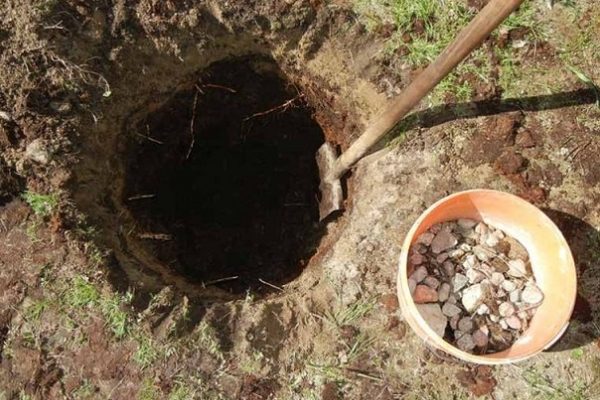
In the pit prepared in advance, the soil will settle at the time of landing.. This prevents the shrinkage of the soil after planting the seedling, which leads to the deepening of the root collar, and as a result, to the abnormal development of the tree as a whole.
Selection of seedlings and preparation for planting in September
To be completely confident in the quality of planting material, it is better to purchase a sapling in nurseries and garden centers. In the fall, seedlings with an open root system are mainly sold.
To determine the quality seedling can be on the external grounds:
- The central root must have at least 30 cm and 4-5 branches. with lots of fouling roots. The roots must be elastic and not overdried without mechanical damage, traces of rot and painful seals.
- It is important to pay attention to the proportionality of the roots and crown. If the seedling has a large surface area and there is no mass of overgrowing roots, this indicates a violation of the technology of digging.
- A healthy seedling has a uniformly developed crown and pronounced skeletal branches. The bark is dense with no traces of flaking, swelling and cracks. According to the state of the outer part, it is possible to judge the strength of the seedling with a closed root system.
Before planting the seedling must be re-examined. If signs of damage or rot are found, they should be removed.This is done only with a sharp pruner, the cuts should be transverse. Do not cut the roots unnecessarily. Especially fouling roots, it is they who bear the main load on the absorption of water and nutrients.
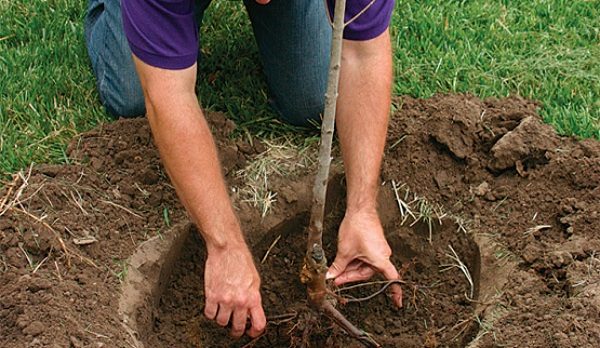
If the roots of a tree have dried up, they need to be held in water for 12-24 hours. Before planting, the roots of the seedling must be dipped in a solution of clay, mullein and water (1: 2: 5) and dry for 30 minutes. On the seedling must remove all the leaves.
How can you plant a seedling in open ground: a step by step guide
Next, consider a step by step guide to planting pears. Focusing on the size of the roots in the planting hole, it is necessary to dig a hole and form a dense mound. Such a height that after the location of the seedling on it, the root neck of the tree remains 5 cm above the ground level. The roots of the tree evenly distributed over the mound. You need to make sure that there are no bends upward, this leads to stunted growth and poor provision of moisture to the seedling.
When filling the root system with the substrate, it is important to control the formation of voids. For this seedling periodically shaken. After that, the ground must be tightly tamped. The seedling is tied to a cola with a soft material, the use of twine and wire is unacceptable.
After this, a hole is made around the trunk, and the seedling is watered with 2-3 buckets of warm water. The near-barrel circle is mulched with peat or sawdust.
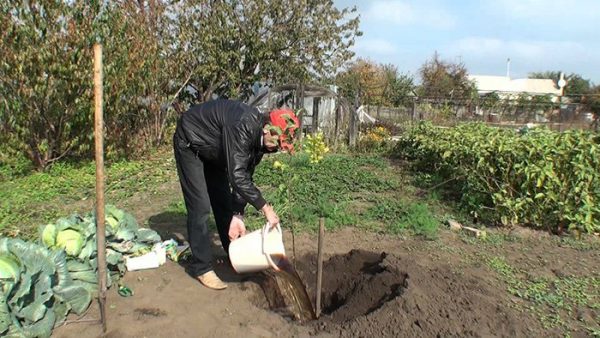
Proper preparation of young pears for the winter
To survive the winter pear seedlings need the help of a gardener. It is necessary to group all the branches of the tree together and firmly fasten to the stake. Check the layer of mulch again, its thickness should be 30 cm.
It is important to protect the trunk of a young pear from frostbite. This must be done before December, the boundary of autumn and winter is characterized by sharp temperature changes. This leads to the appearance of frostbones, destroying the cambium - the main structure that supports the livelihoods of the tree.
To protect the trunk is well suited cotton fabric or other covering materials that allow air to pass through. They are wrapped in a tree shtamb.
You can treat the stem of a young pear with a mixture of mullein and clay (1: 1), the sharp smell of which will scare off rodents. Experienced gardeners wrap the seedling trunk with a fine mesh.
Snow well-known for its thermal insulation properties will help to winter the seedling well. Therefore, it is necessary to pull it to the tree as much as possible. It should be borne in mind that in Siberia and the Urals a different amount of precipitation falls. Therefore, the preparation of pears for winter will differ slightly in these regions.
How to transplant an adult pear to a new place?
Now let's talk about transplanting pears to a new place. An adult pear painfully tolerates a transplant. This process is especially destructive for trees older than 15 years, they are not recommended to replant. This is due to the fact that pears have a tap root system that is deeply buried. therefore pear transplanted only when urgently needed.
Digging pears
Preparation for the autumn transplant of an adult tree should begin in the spring. To minimize the level of stress for the fruit tree, you must adhere to certain rules:
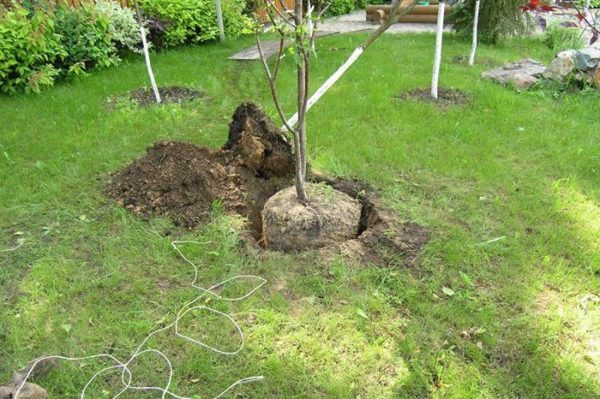
- spring-digging around the perimeter of the crown with chopping off the opposite roots;
- in the fall, before planting, the near-stem circle is plentifully spilled;
- for trees up to 5 years, the near-stem circle is dug in a circle at a distance of 0.7 m from the trunk, forming a cone-shaped earthen clod 70 cm deep (for older trees, 130 cm from the trunk and 1 m deep);
- a trench 50 cm wide dug around the earthy coma and for its entire depth;
- the roots that extend beyond the limits of the earthen cone are cut off, and those that go deep into the ground are cut with a sharp shovel;
- the tree is taken out with an earthy clod and laid on cellophane, which is tightly knotted around the trunk.
If the pear is to be transported, the roots are laid on a layer of sawdust, this minimizes their damage during shaking. Now you know when you can transplant a pear to another place.
Transplanting and caring for a tree
The prepared pit for planting an adult pear should be 40 cm wider and deeper than an earthen ball.A substrate of fertile soddy soil and humus (peat) is laid on its bottom, and it is well tamped.
Regarding the cardinal points, the pear is placed similarly to the previous place. The tree in the planting pit is installed taking into account the root collar, it should not be buried. The gap between the walls of the pit earthy lump asleep fertile soil and tamped.
A sapling must be poured generously, covered the ground with earth and covered the okolostvolny circle. Before the winter season it is necessary to protect the tree from freezing.
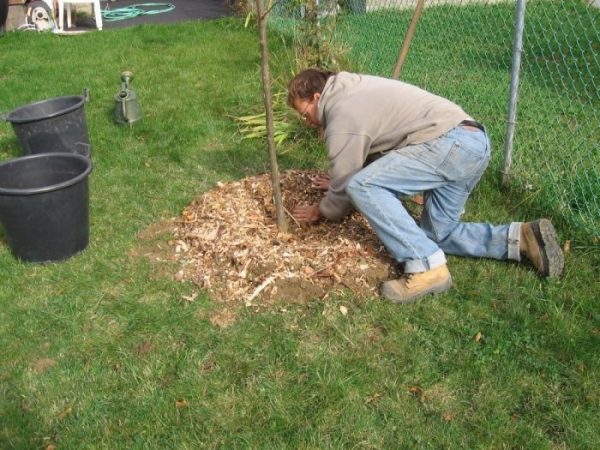
After the transplanted pear leaves the state of dormancy and before the kidneys swell, it is important to carry out a rejuvenating pruning. A strongly reduced tree root system will not be able to provide the former vegetative mass with the necessary nutrition. At branches of trees up to 5 years old, a 2-3-year growth is cut off, and in older adults, a 3-5-year growth is cut off.
Pear care should be carried out in the spring and summer. In the first half of summer, the tree is fertilized with a solution of nitrophoska (250 ml) and water (10 l).For foliar application, a 0.3% urea solution is used. In dry weather, the tree should be regularly watered. Cut the pear before August in the summer is not worth it.
In the first year, there will be a minimal increase in the transplanted pear, but the next years the tree will develop in the standard mode.
And finally, we offer to watch a video on how to plant a pear in autumn:
